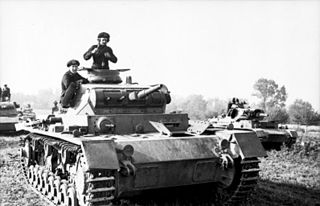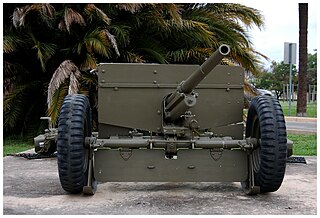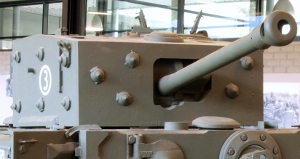 W
WThe 2 cm KwK 30 L/55 (2 cm Kampfwagenkanone 30 L/55) was a German 2 cm cannon used as the main armament of the German Sd.Kfz.121 Panzerkampfwagen II light tank and various reconnaissance vehicles. It was used during the Spanish Civil War and the Second World War. It was produced by Mauser and Rheinmetall-Borsig from 1935.
 W
WThe 3,7cm ÚV vz. 38, manufacturer's designation Škoda A7, was a 37 mm tank gun designed by the Skoda Works in Czechoslovakia prior to World War II.
 W
WThe 3,7 cm KPÚV vz. 34 was an anti-tank gun produced by the Škoda Works in Czechoslovakia. Škoda's own designation for it was A3. It is not known if guns seized by Germany after the occupation of Bohemia-Moravia saw service in World War II. Slovakia acquired 113 when it declared independence from Czechoslovakia in March 1939.
 W
WThe 3.7 cm KwK 36 L/45 (3.7 cm Kampfwagenkanone 36 L/45) was a German 3.7 cm cannon used primarily as the main armament of earlier variants of the German Sd.Kfz. 141 Panzerkampfwagen III medium tank. It was used during the Second World War.
 W
WThe 5 cm KwK 38 L/42 (5 cm Kampfwagenkanone 38 L/42) was a German 50 mm calibre cannon used as the main armament of variants of the German Sd.Kfz. 141 Panzerkampfwagen III medium tank during the Second World War. There was no towed anti-tank gun equivalent.
 W
WThe 5 cm KwK 39 L/60 (5 cm Kampfwagenkanone 39 L/60) was a German 50 mm calibre tank gun used during the Second World War, primarily as the main armament of later models of the German Panzer III tank from December 1941 onwards. It was produced when the well-armoured T-34 and KV-1 tanks were encountered in ever increasing numbers on the Eastern Front, although it was only partially successful in its role. It was later superseded by the 7.5 cm KwK 40 L/43.
 W
WThe 7.5 cm KwK 37 L/24 (7.5 cm Kampfwagenkanone 37 L/24) was a short-barreled, howitzer-like German 75 mm tank gun used during World War II, primarily as the main armament of the early Panzer IV tank. Slightly modified as StuK 37, it was also mounted in early StuG III assault guns.
 W
WThe 7.5 cm KwK 40 (7.5 cm Kampfwagenkanone 40) was a German 75 mm Second World War era vehicle-mounted gun, used as the primary armament of the German Panzer IV (F2 models onwards) medium tank and the Sturmgeschütz III (F models onwards) and Sturmgeschütz IV tank destroyers/assault guns.
 W
WThe 7.5 cm KwK 42 L/70 was a 7.5 cm calibre German tank gun used on German armoured fighting vehicles in the Second World War. The gun was the armament of the Panther medium tank and two variants of the Jagdpanzer IV self-propelled anti-tank gun. On the latter it was designated as the "7.5 cm Panzerabwehrkanone 42" anti-tank gun.
 W
WThe 8.8 cm KwK 36 was an 88 mm tank gun used by the German Army during World War II. This was the primary armament of the PzKpfw VI Tiger I tank. It was developed and built by Krupp.
 W
WThe 8.8 cm KwK 43 was an 88 mm 71 calibre length tank gun designed by Krupp and used by the German Wehrmacht during the Second World War. It was mounted as the primary armament on the Panzerkampfwagen VI Ausf. B Tiger II. The 8.8 cm Pak 43, an anti-tank gun, was very similar in design but mounted on tank destroyers or deployed stand-alone on the field.
 W
WThe 37 mm gun M3 is the first dedicated anti-tank gun fielded by United States forces in numbers. Introduced in 1940, it became the standard anti-tank gun of the U.S. infantry with its size enabling it to be pulled by a jeep. However, the continuing improvement of German tanks quickly rendered the 37 mm ineffective and, by 1943, it was being gradually replaced in the European and Mediterranean theaters by the more powerful British-developed 57 mm gun M1. In the Pacific, where the Japanese tank threat was less significant, the M3 remained in service until the end of the war, but some 57mm guns were issued.
 W
WThe ZiS-2 was a Soviet 57-mm anti-tank gun used during World War II. The ZiS-4 was a version of the gun meant to be installed in tanks. ZiS stands for Zavod imeni Stalina, the official title of Artillery Factory No. 92, which produced the gun first.
 W
WThe 75 mm gun was the standard American gun mounted to a mobile platform during World War II. They were primarily mounted on tanks, but were also mounted on the B-25 Mitchell medium bomber aircraft. There were five variants used during the war: M2, M3, M4, M5, and M6.
 W
WThe 76 mm gun M1 was an American World War II–era tank gun developed by the U.S Ordnance Department in 1942 to supplement the 75 mm gun on the basic Medium tank M4. It was also used to arm the M18 Hellcat tank destroyer.
 W
WThe 76 mm tank gun M1940 F-34 was a 76.2 mm Soviet tank gun used on the T-34/76 tank. A modified version of the gun, the 76 mm tank gun M1941 ZiS-5, was used on KV-1 tanks during World War II. Nowadays, the two versions are often referred to just by their factory designations, as "F-34" and "ZiS-5", respectively.
 W
WThe 85 mm air defense gun M1939 (52-K) was an 85 mm (3.3 in) Soviet anti-aircraft gun, developed under guidance of leading Soviet designers M. N. Loginov and G. D. Dorokhin. This gun was successfully used throughout the German-Soviet War against level bombers and other high- and medium-altitude targets. In emergencies they were utilized as powerful anti-tank weapons. The barrel of the 52-K was the basis for the family of 85-mm Soviet tank guns. After the war some 52-Ks were refitted for peaceful purposes as anti-avalanche guns in mountainous terrain.
 W
WThe L-11 76.2 mm tank gun was a Soviet tank gun, used on the earliest models of the T-34 Model 1940 medium tank and KV-1 Model 1939 heavy tank during World War II.
 W
WThe Ordnance QF 3 pounder gun was a 47 mm British tank gun based on the Ordnance QF 3 pounder Vickers naval gun, mounted on Vickers-built tanks in the 1920s and 1930s. The gun was produced in 31 calibre and 40 calibre versions. The weapon only fired a solid shot, and was stated in the requirements of the A6 series of Vickers Medium tanks to have the ability to penetrate the armour of contemporary hostile tanks at a range of 1000 yards. The Vickers Medium Mark I was equipped with the Ordnance Quick Firing 2cwt Mark I version of the weapon, whilst from the Vickers Medium Mark II the Mark II version of the 3-pounder was utilized.
 W
WThe Ordnance Quick-Firing 17-pounder was a 76.2 mm (3 inch) gun developed by the United Kingdom during World War II. It was used as an anti-tank gun on its own carriage, as well as equipping a number of British tanks. Used with the APDS shot, it was capable of defeating all but the thickest armour on German tanks. It was used to 'up-gun' some foreign-built vehicles in British service, notably to produce the Sherman Firefly variant of the US M4 Sherman tank, giving British tank units the ability to hold their own against their German counterparts. In the anti-tank role, it was replaced after the war by the 120 mm BAT recoilless rifle. As a tank gun, it was succeeded by the 84 mm 20 pounder.
 W
WThe Ordnance QF 32 pounder or (32-pdr) was a British 94 mm gun, initially developed as a replacement for the Ordnance QF 17-pdr anti-tank gun.
 W
WThe Ordnance QF 2-pounder, or simply "2 pounder gun", was a 40 mm (1.575 in) British anti-tank and vehicle-mounted gun employed in the Second World War.
 W
WOrdnance QF 3 inch howitzer was a howitzer fitted to British cruiser and infantry type tanks of the Second World War so they could fire a smoke shell in "close support" of other tanks or infantry. HE shells were also available. Earlier British tanks were fitted with a 3.7 in howitzer.
 W
WThe Ordnance Quick-Firing 6-pounder 7 cwt, or just 6-pounder, was a British 57 mm gun, serving during the Second World War as a primary anti-tank gun of both the British and United States Army. It was also used as the main armament for a number of armoured fighting vehicles.
 W
WThe Ordnance Quick-Firing 17-pounder was a 76.2 mm (3 inch) gun developed by the United Kingdom during World War II. It was used as an anti-tank gun on its own carriage, as well as equipping a number of British tanks. Used with the APDS shot, it was capable of defeating all but the thickest armour on German tanks. It was used to 'up-gun' some foreign-built vehicles in British service, notably to produce the Sherman Firefly variant of the US M4 Sherman tank, giving British tank units the ability to hold their own against their German counterparts. In the anti-tank role, it was replaced after the war by the 120 mm BAT recoilless rifle. As a tank gun, it was succeeded by the 84 mm 20 pounder.
 W
WThe Ordnance QF 75 mm, abbreviated to OQF 75 mm, was a British tank gun of the Second World War. It was obtained by boring out the Ordnance QF 6-pounder 57 mm anti-tank gun to 75 mm, to give better performance against infantry targets in a similar fashion to the 75 mm M3 gun fitted to the American Sherman tank. The QF came from "quick-firing", referring to the use of ammunition where the shell has a fixed cartridge. The gun was also sometimes known as ROQF from Royal Ordnance Quick-Firing.
 W
WThe Ordnance QF 95-mm howitzer was a British howitzer built in two versions during the Second World War. The tank howitzer version was accepted for service use, but the infantry version was not.
 W
WThe Type 5 75 mm tank gun was used as the main armament of the Imperial Japanese Army prototype Type 4 Chi-To medium tank. It was one of the largest tank guns to be fitted on a World War II Japanese tank. Due to late war shortage-induced delays only two were ever mounted in a completed Type 4 Chi-To, neither of which saw combat use. The tank gun was also used on the prototype Type 5 Chi-Ri medium tank and prototype Type 5 Na-To tank destroyer.